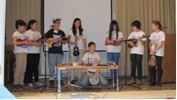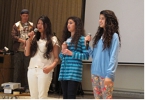“I found a different way of seeking peace.” That’s what a young child wrote in her reaction paper after the closing of the event titled Cross Border Youth Art Festival.

On March 4th 2014, we met at our usual meeting spot at Damascus Gate, with a burning sun muted by a tepid breeze. We got into the bus in the direction of the Tantur Ecumenical Institute to go to the second annual Cross Border Youth Art Festival organized by Seeds of Peace Women of Action, with the support of USAID.


This association is a collective of committed women working for the gathering of young Israeli and Palestinians around varied activities which aim to encourage closer relations and to get to know each other through the beautiful means of the arts.
Having just arrived, we were welcomed by some children already there and by the organizers of the event. From the very beginning, the atmosphere was palpable. The rooms were prepared for the activities of the day and the gallery was covered by the children works, and some of them were really masterpieces.
Slowly the hall was filling up while the buffet at the entry was emptying. Then quickly, the main room was filled by young girls and boys with enchanting smiles. During the presentation, Rima and Lisa from the Women of Action organization were revealing the program of the day. And strangely, even if what the ladies were saying was really interesting, we couldn’t stop starring at the young teenagers who, shyly but amused, were already looking above their shoulders, on the right, on the left, inspecting their neighbours, curious. Their face expressions were the promise of a beautiful day.
Starting with music
Just after the remarks from organizers, eight children showed up on the stage and started playing ukuleles and singing in Arabic, Hebrew, and English. They warmed the atmosphere of the room, and all the audience clapped their hands and sometimes sang together.
“Well open up your mind and see like me/ Open up your plans and damn you’re free/ Look into your heart and you’ll find love” Whatever the languages were, the lyrics touched everybody.

Drama: A way for bodies to express what sometimes words cannot
The program contained four parts: Drama, Games, Gallery and Music. For the first part, drama was held in a room with 30 children from group C.
The facilitator told the children to make a circle. Then he set a rule: Not to speak. As a first step, children walked around the room trying to find an empty space. They had to change their speed to walk. If the facilitator says “1”, they had to walk really slowly, if he tells them “5” they had to move as fast as they can. He sometimes made them “Freeze!” with a bunch of laughter echoing watching the frozen position of their neighbours. Gradually, children got used to changing their speed to walk, and to freeze. By that activity, it seemed that the children were really discovering something about expressing through their body.
For the second part, the facilitator set another situation. Imagine your mother threw a 3 million shekel winning lottery ticket in the washing machine by mistake. Children had to express their reaction in response to the situation. Some of them cried, some of them were getting angry, and sometimes they shook some other person’s shoulder. After that, as a third step, he explained that it turned out to be YOURSELF who threw the money by mistake. Believe me the scene became hilarious. The main point of all this was learning how to forgive ourselves about something serious and delicate that we did.
The next step was a discussion about how important it is to forgive ourselves, in order to foster peace. Peace will not be achieved without self forgiveness. Absence of forgiving and accepting yourself never leads us to forgive or accept others.
After these words, the children played a last situation: Diving into pairs of youth who don’t know each other, they had to create a 30 second drama scene, illustrating a situation of conflict and then a pragmatic reconciliation. Children prepared their drama for 5 minutes, and then they performed it in front of the other participants.
Let’s take one of these scenes: one team performed a scene with a chair. One of the two was sitting on the chair first. The other one distracted him and while he was standing, she stole the chair. He then sees the trick she played, and starts getting angry at her and complains about it. However after few seconds, he calmed down, took another chair, and sat on this other chair along with hers. She then stood up from the chair, and they switched places to sit in the other chair.
The way they forgive each other varied in multiple ways: Creating an alternative for the other like that example, or sharing one thing by both of them, and giving up something for the other. Every one of these ways can be applied to the actual conflict in the Middle-East. What they performed simply surprised us a lot.
Games and Gallery: Sharing the goal and feeling somebody’s image of peace
In the afternoon, the children gathered in the room again and separated into two groups. Each group made a circle and held their hands. The facilitator put a hula-hoop in their arms, and they had to pass the hula-hoop to the next person by crawling under the hula-hoop or crossing-over it. In order to pass the hula-hoop to the next person as fast as possible, they had to understand their height difference, or guessing how the next one will try to pass it to you and how you can support him. Another game used straws and rubber-bands. The game was different from the other, even though they had to overcome the same logic of playing together. They had to care how their neighboring person moves and cooperate in order to win the game. The game demonstrates that if there is one mutual goal to wish for and the goal is shared among the stakeholders, it would be much easier to start cooperating for achieving the goal.
After that, the facilitator changed the place to gallery, and told the youth to look at the paintings of Israeli and Palestinian children. She gave them a few small papers, and told them to write comments about the art works. The children walked around looking at the works, really focused, and wrote comments about them. The works were placed randomly, so they could see the works without knowing which one was made by whom. If there is no information which may affect their way of seeing the works beforehand, they can see those works without categorizing them.
Dance & Sing for peace

After the gallery, the children gathered in the big main room to watch the incredible and touching performances of the kids. Several singers, one trio and a group performed Arabic and English songs with a palpable wish to send their joy and love to the audience. They sang with faith, they danced with pride, they sang through love, they danced for their new friends. As we all know that it’s difficult to perform in public, even more at their ages in front of people they barely knew, it was beautiful to see how easy they did it this day. Something was pushing them, something gave them trust.


A closing “Rendezvous”
Around 16:00, Daniel gathered the remaining people and used the moment to thank all the kids for their participation and also the enormous preparation work of the organizers. The day was truly a real success. Coming from the four corners of Israel and Palestine, these kids lived, together, an unforgettable experience. By sharing their taste for Arts and for fun, these young male and female teenagers genuinely met each other. Their encounter is not trifling, and all the significance of this day lies in this truth: Thanks to this time of sharing and meeting, each one of these kids has seen in his/her neighbour the reflection of their own person. This day permitted everyone to see in his neighbour the same appetite for life and the same curiosity that they have. Therefore, prejudices and misconceptions faded little by little in favor of something bigger: Friendship.

By their presence, their participation and their volunteer collaboration during this day, these young people participated in something enormous, in the most beautiful way: they work to repair the mistakes of the past and fill the gaps of differences, to build a viable future free from hatred and mistrust.
Through this meeting, they learnt a lot from each other and realized their similar nature. They metaphorically demolished the mental wall separating these two peoples. By refusing to recognize a difference between them through sharing and joy, they on this day proved their surprisingly early maturity and magnanimity.
Their guidelines naturally emerged: breaking through the prejudices of their environment (sometimes made of mistrust and racism) to break down the barriers: “Leave us kids alone!” as the Ukuleles for Peace rightly sang, it’s not their fight anymore. Now the only fight that remains is building peace.
https://www.youtube.com/watch?v=E1nFpK_f-Fk&feature=youtu.be